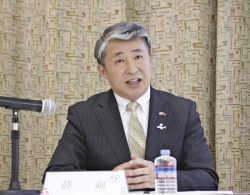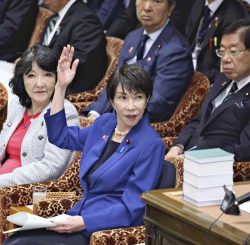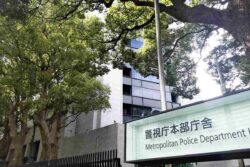Digital torrent / Jumble of new systems created chaotic response to pandemic in Japan

A city official in Ashikaga, Tochigi Prefecture, checks the vaccination record of a local resident for input into the VRS at city hall on July 29. (The photo was partially modified)
19:49 JST, September 11, 2021
The COVID-19 pandemic shined a spotlight on the delay in the digitizing of society, a centerpiece policy of Prime Minister Yoshihide Suga aimed at smoothing administrative procedures.
Suga put the issue in the forefront after the bitter experience of seeing the government’s “analog dependent” response at the start of the pandemic, which occurred while he was Chief Cabinet Secretary.
Lack of cooperation
The initial response by the Cabinet of then Prime Minister Shinzo Abe was chaotic. Public health centers would receive a report of confirmed infection cases by fax from medical institutions, and manually input the information of infected individuals into their computers.
As the number of newly infected grew day by day, processing capability could not keep up, causing delays in the compilation of accurate data. To address the situation, the Health, Labor and Welfare Ministry last May began using the HER-SYS system that allows medical institutions to directly input data on infected patients, but the many items needed to be input made it time consuming.
When the government provided a uniform ¥100,000 benefit to all residents, online applications overwhelmed the system, prompting local governments one after another to resort to having people apply by mail.
The Suga administration also stumbled in the rollout of vaccines. The Cabinet Secretariat’s IT strategy office, which is in charge of preparing for the launch of the Digital Agency, handled the Vaccination Record System (VRS) for recording and managing vaccinations, but did not get it to operate well.
“Vaccination records of residents have to be input into both the VRS and the system that our city created on its own,” said Akihiro Kimura, head of the city coronavirus response office of Ashikaga, Tochigi Prefecture.
The VRS records such details as the names of inoculated residents and dates of vaccinations, but does not have the function of managing reservations for vaccinations. The two doses of the vaccine need to be administered at a specific interval, making it necessary that the date of the first shot and the reservation date for the second be handled simultaneously. The Ashikaga city government decided to use its own system, which included this function, together with the VRS, but priority was put on inputting information into its own system.
As a result, there were nearly 20,000 cases of data not yet input into the VRS in early July. Ashikaga was not alone. Many local governments got backlogged inputting information, leaving the central government unable to grasp how the vaccination rollout was progressing.
Behind this disorderly jumble of new systems was a lack of cooperation between government agencies and between the central and local governments.
The health ministry initially planned to use the “immunization register” that each municipal government already keeps for other vaccinations, but later found that it would take two to three months before the records could be processed. The Prime Minister’s Office regarded this as problematic, and the IT strategy office decided to introduce the VRS at the beginning of this year.
However, by that time, Ashikaga and numerous other local governments had already begun creating their own systems. “The central government failed to coordinate on how a nationwide system should be built,” Kimura pointed out.
There were also glitches in COCOA, a smartphone app introduced by the health ministry to notify those who may have come into contact with an infected person. There were cases of the notifications not being sent, and the problem was left unfixed. Not only did health ministry officials lack knowledge about the app, there was a lack of cooperation with the contractor that designed it.
Sense of crisis
The central government’s sense of crisis is strong. “Neither the collaboration between the public and private sectors nor between the central and local governments was enough,” Takuya Hirai, appointed as digital minister, said in remorse, then stressed that the Digital Agency launched in September will create systems easier for local governments to use.
A major role for the Digital Agency will be to standardize systems used by the central and local governments, thereby smoothing the way for cooperation. A common platform will be developed for the central government’s ministries and agencies, while a system will be prepared for local governments with standard specifications for links to each sector.
In this way, the cacophony of multiple systems can be avoided. “For example, if there is a future outbreak of a new infectious disease, the central government can create a unified system to manage all data, from the delivery and stockpile of vaccines to the vaccination records of individuals,” an official in charge at the IT strategy office explained. “This will be accessible by every ministry and agency and local government all around the country.”
Voices of concern
The central government is aiming to have all local governments switched over to the standardized system by fiscal 2025. The timeline, initially set vaguely as “sometime in the 2020s,” was made clearer at the command of the prime minister.
While the central government has been rushing to get local governments on board, there are those critical of the move. “Large-scale local governments have been carrying out their own administrative services for residents and have their own systems,” an Osaka City official said. “It will be difficult to standardize everything by fiscal 2025.”
Local governments across the country have expressed uneasiness with the plan, wondering if the project will steadily progress.
The Digital Agency is an organization meant to help extend the benefits of digitization to the people. There are many issues that still need to be addressed to achieve Suga’s vision of “digitization that is user-friendly and leaves no one behind,” such as thoughtfully grasping the actual situation of local governments that cannot make the shift and extending support to them.
"Politics" POPULAR ARTICLE
-

Japan to Charge Foreigners More for Residence Permits, Looking to Align with Western Countries
-

China Would Cut Off Takaichi’s ‘Filthy Head’ in Taiwan Crisis, Diplomat Allegedly Says in Online Post
-

If China Were to Impose Blockade on Taiwan, Existential Crisis Could Be Triggered, Japan’s Prime Minister Takaichi Says
-

Japan to Tighten Screening of Foreigners’ Residential Status by Providing Information of Nonpayment of Taxes
-

Takaichi Cabinet Approval Holds at 72% as Voters Back Aggressive Fiscal Stimulus, Child Benefits
JN ACCESS RANKING
-

Govt Plans to Urge Municipalities to Help Residents Cope with Rising Prices
-

Japan Resumes Scallop Exports to China
-

Japan Prime Minister Takaichi Vows to Have Country Exit Deflation, Closely Monitor Economic Indicators
-

Japan to Charge Foreigners More for Residence Permits, Looking to Align with Western Countries
-

JR East Suica’s Penguin to Retire at End of FY2026; Baton to be Passed to New Character
























